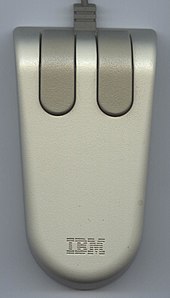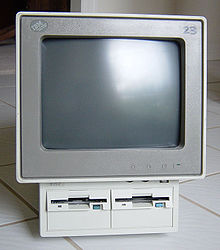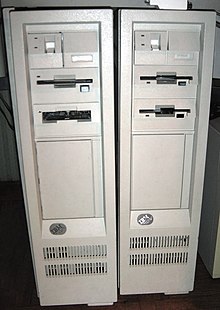IBM PS/2
This article includes a list of general references, but it lacks sufficient corresponding inline citations. (February 2011) |
This article needs additional citations for verification. (February 2011) |
 IBM Personal System/2 Model 55 SX | |
| Developer | International Business Machines Corporation (IBM) |
|---|---|
| Type | Professional Computer |
| Release date | April, 1987 |
The Personal System/2 or PS/2 was IBM's third generation of personal computers. The PS/2 line, released to the public in 1987, was created by IBM in an attempt to recapture control of the PC market by introducing an advanced proprietary architecture. Although IBM's considerable market presence ensured the PS/2 would sell in relatively large numbers, the PS/2 architecture ultimately failed in its bid to return control of the PC market to IBM. Due to the higher costs of the closed architecture, customers preferred competing PCs that extended the existing PC architecture instead of abandoning it for something new. However, many of the PS/2's innovations, such as the 16550 UART, 1440 KB 3.5-inch floppy disk format, 72-pin SIMMs, the PS/2 keyboard and mouse ports, and the VGA video standard, went on to become standards in the broader PC market.
The OS/2 operating system was announced at the same time as the PS/2 line and was intended to be the primary operating system for models with Intel 286 or later processors. However, at the time of the first shipments, only PC-DOS was available, with OS/2 1.0 (text-mode only) available several months later. IBM also released AIX PS/2, a UNIX operating system for PS/2 models with Intel 386 or later processors. Windows was another option for PS/2.
Technology
IBM's PS/2 was designed to remain software compatible with their PC/AT/XT line of computers upon which the booming PC clone market was built, but the hardware was quite different. PS/2 had two BIOSes — one was named ABIOS (Advanced BIOS) which provided a new protected mode interface and was used by OS/2; the other was named CBIOS (Compatible BIOS) which was included in order for the PS/2 to be software compatible with the PC/AT/XT.
Micro Channel Architecture
The IBM Personal System/2 line introduced the Micro Channel Architecture (MCA for short), which was technically superior to the ISA bus and allowed for higher speed communications within the system. The MCA bus featured many advances that would not be seen in other interface standards until several years later. Transfer speeds were on par with the much later introduced PCI bus standard. MCA allowed one-to-one, card to card, and multi-card to processor simultaneous transaction management which is a feature of the PCI-X bus format. Bus mastering capability, bus arbitration, and true plug-and-play BIOS management of hardware were all benefits of the MCA bus. Despite all of these technical advantages, the Micro Channel Architecture never gained wide acceptance outside of the PS/2 line due to IBM's anti-clone practices and incompatibilities with ISA. IBM offered to sell a Micro Channel license to anyone who could afford the royalty, but they not only required a royalty for every MCA-compatible machine sold, but also a payment for every IBM-compatible machine the particular maker had ever made in the past.[citation needed]
Keyboard/mouse interface


PS/2 systems introduced a new specification for the keyboard and mouse interfaces, which are still in use today and are thus called "PS/2" interfaces. The PS/2 keyboard interface was electronically identical to the long-established AT interface, but the cable connector was changed from the 5-pin DIN connector to the smaller 6-pin mini-DIN interface. The same connector and a similar synchronous serial interface was used for the PS/2 mouse port. Additionally, the PS/2 introduced a new software data area known as the Extended BIOS Data Area (EBDA). Its primary use was to add a new buffer area for the dedicated mouse port. This also required making a change to the "traditional" BIOS Data Area (BDA) which was then required to point to the base address of the EBDA.
Graphics
Most of the initial range of PS/2 models were equipped with a new frame buffer known as the Video Graphics Array, or VGA for short. This effectively replaced the previous EGA standard. VGA increased graphics memory to 256 KiB and provided for resolutions of 640×480 with 16 colors, and 320×200 with 256 colors. VGA also provided a palette of 262,144 colors (as opposed to the EGA palette of 64 colors). The IBM 8514 and later XGA computer display standards were also introduced on the PS/2 line. Although the design of these adapters did not become an industry standard as VGA did, their 1024×768 pixel resolution was subsequently widely adopted as a standard by other manufacturers, and "XGA" became a synonym for this screen resolution. The PS/2 Model 25 and Model 30, however, did not include VGA. On these budget models, IBM opted to use MCGA, which was a stepping stone between CGA and VGA, but unfortunately lacked EGA compatibility.

VGA video connector
All of the new PS/2 graphics systems (whether MCGA, VGA, 8514, or later XGA) used a 15-pin mini-D connector for video out. This used analog RGB signals, rather than fixed sixteen or sixty-four color lines as on previous CGA and EGA monitors, allowing arbitrary increases in the color depth (or levels of grey) compared to its predecessors. It also allowed for analog grayscale displays to be connected; unlike earlier systems (like MDA and Hercules) this was transparent to software, allowing all programs supporting the new standards to run unmodified whichever type of display was attached. These greyscale displays were relatively inexpensive during the first few years the PS/2 was available, and very commonly purchased with lower-end models. The VGA connector became a near universal standard for connecting monitors and projectors over the course of the early 1990s, replacing a variety of earlier connectors on non-PC hardware. Recently other standards (primarily DVI and HDMI for digital flat panel displays) have become common as well, but none have yet become as common as the VGA connector.
External storage
Although 3.5" floppy disks were becoming common in the industry by 1987, the PS/2s were the first IBM models to use them as standard, relegating the 5.25" format to an expensive, optional external accessory drive. While the disk format itself was standard, IBM chose to use a non-standard form for the disk drives, resulting in very high repair costs as a standard drive could not be retrofitted to a PS/2. The IBM part was functionally identical to a standard 3.5" floppy drive.[citation needed] In the initial line-up, IBM used 720 kB Double Density (DD) capacity drives on the 8086-based models and 1.44 megabytes High Density (HD) on the 80286-based and higher models. By the end of the PS/2 line they had moved to a somewhat standardized capacity of 2.88 MB. The PS/2 floppy drives were famous for not having a capacity detector. 1.44 MB floppies had a hole so that drives could identify them from 720 kB floppies, preventing users from formatting the smaller capacity disks to the higher capacity (doing so would work, but with a higher tendency of data loss). Clone manufacturers implemented the hole detection, but IBM did not. As a result of this a 720 kB floppy could be formatted to 1.44 MB in a PS/2, but the resulting floppy would only be readable by a PS/2 machine.[1]
Memory
The PS/2 introduced the 72-pin RAM SIMM, which became the de facto standard for RAM modules by the mid-90s in mid-late 486 and early Pentium desktop systems. SIMMs were 32 or 36 bits wide, and replaced the old 30-pin (8/9-bit) SIPP standard, which was much less convenient as SIPPs had to be used four at a time to match the bus width of a system with a 32-bit bus. 72-pin SIMMs were also capable of larger maximum capacities.
Models
At launch, the PS/2 family comprised the Model 30, 50, 60 and 80; the Model 25 was launched a few months later.
The PS/2 Models 25 and 30 (IBM 8525 and 8530 respectively) were ISA-based (in other words, essentially IBM PC-like systems in a different form factor) systems, originally only available with Intel 8086 CPUs. These machines also differed from other PS/2 models in having 720k floppy disk drives, an ST506-compatible hard drive controller and MCGA graphics. The hard drives were available as an optional part; however, many of these entry-level machines were sold without hard drives due to the high cost.

The Model 25 featured an integrated monochrome or color monitor to compete with the Apple Macintosh as an integrated system for educational environments. An external "paper white" monochrome screen was also available as a cost-saving model instead of the standard VGA display; this was often paired with the Model 30.
Later ISA PS/2 models comprised the Model 30-286 (a Model 30 with an Intel 286 CPU), Model 35 (IBM 8535) and Model 40 (IBM 8540) with Intel 386SX or IBM 386SLC processors.
The higher-numbered models were equipped with the MicroChannel bus and mostly ESDI or SCSI hard drives (models 60-041 and 80-041 being MFM based). PS/2 Models 50 (IBM 8550) and 60 (IBM 8560) used the Intel 286 processor, the PS/2 Models 70 (IBM 8570) and 80 used the 386DX, while the medium-performance PS/2 Model 55SX (IBM 8555-081) used the 16/32-bit 386SX processor. Later Model 70 and 80 variants (B-xx) also used 25 MHz Intel 486 processors, in a complex called the Power Platform.


The PS/2 Models 90 (IBM 8590/9590) and 95 (IBM 8595/9595/9595A) used Processor Complex daughterboards holding the CPU, memory controller, MicroChannel bus interface, and other system components. The available Processor Complex options ranged from the 20 MHz Intel 486 to the 90 MHz Pentium and were fully interchangeable. The IBM PC Server 500, which has a motherboard identical to the 9595A, also uses Processor Complexes.
Other later MicroChannel PS/2 models included the Model 65SX with a 16 MHz 386SX; various Model 53 (IBM 9553), 56 (IBM 8556) and 57 (IBM 8557) variants with 386SX, 386SLC or 486SLC2 processors; the Models 76 and 77 (IBM 9576/9577) with 486SX or 486DX2 processors respectively; and the 486-based Model 85 (IBM 9585).
The IBM PS/2E (IBM 9533) was the first Energy Star compliant personal computer. It had a 50 MHz IBM 486SLC processor, an ISA bus, four PC card slots, and an IDE hard drive interface. The environmentally-friendly PC borrowed many components from the ThinkPad line and was composed of recycled plastics, designed to be easily recycled at the end of its life, and used very little power.
IBM also produced several portable and laptop PS/2s, including the Model L40 (ISA-bus 386SX), N51 (386SX/SLC), P70 (386DX) and P75 (486DX2).
The IBM PS/2 Server 195 and 295 (IBM 8600) were 486-based dual-bus MCA network servers supporting asymmetric multiprocessing, designed by Parallan Computer Inc.
The IBM PC Server 720 (IBM 8642) was the largest MCA-based server made by IBM, although it was not, strictly speaking, a PS/2 model. It could be fitted with up to six Intel Pentium processors interconnected by the Corollary C-bus and up to eighteen SCSI hard disks. This model was equipped with seven combination MCA/PCI slots.
The IBM ThinkPad 700C, aside from being labeled "700C PS/2" on the case, featured MicroChannel architecture and a 486SLC CPU.
Marketing
The PS/2's controversial hardware design was tied to a marketing strategy that was similarly unsuccessful. During the 1980s, IBM's advertising of the original PC and its other product lines had frequently used the likeness of Charlie Chaplin. For the PS/2, however, IBM augmented this character with a notorious jingle that seemed more suitable for a low-end consumer product than a business-class computing platform:
- “How ya' gonna' do it?
PS/2 It!
It's as easy as I.B.M.”
- “How ya' gonna' do it?
PS/2 It!
The solution is I.B.M.”
Another campaign featured the actors from the television show M*A*S*H playing updated versions of their characters from the series.
The profound lack of success of these advertising campaigns led, in part, to IBM's termination of its relationships with its global advertising agencies; these accounts were reported by Wired magazine to have been worth over $500 million a year, and the largest such account review in the history of business.[2]
Overall, the PS/2 line was largely unsuccessful with the consumer market, even though the PC based Models 30 and 25 were an attempt to address it. With what was widely seen as a technically competent but cynical attempt to gain undisputed control of the market, IBM unleashed an industry and consumer backlash. The firm suffered massive financial losses for the remainder of the decade, forfeited its previously unquestioned position as the industry leader, and eventually lost its status as the largest single manufacturer of personal computers (ironically, only after it decided to deemphasize Microchannel), first to Compaq and then to Dell. Still, the platform experienced success in the business sector where the reliability, ease of maintenance and strong support from IBM offset the rather daunting cost of the machines. Also many people still lived with the motto "Nobody ever got fired for buying an IBM." The model 55SX and later 56SX were the leading sellers for almost their entire lifetimes. Many models of PS/2 systems saw a production life span that took them well into the late 1990s.
See also
References
- ^ Formatting 720K Disks on a 1.44MB Floppy
- ^ Wired, Issue 3.08, August 1995
Further reading
- Burton, Greg. IBM PC and PS/2 pocket reference. NDD (the old dealer channel), 1991.
- Byers, T.J. IBM PS/2: A Reference Guide. Intertext Publications, 1989. ISBN 0-07009-525-6.
- Dalton, Richard and Mueller, Scott. IBM PS/2 Handbook . Que Publications, 1989. ISBN 0-88022-334-0.
- Held, Gilbert. IBM PS/2: User's Reference Manual. John Wiley & Sons Inc., 1989. ISBN 0-47162-150-1.
- Hoskins, Jim. IBM PS/2. John Wiley & Sons Inc., fifth revised edition, 1992. ISBN 0-47155-195-3.
- Leghart, Paul M. The IBM PS/2 in-depth report. Pachogue, NY: Computer Technology Research Corporation, 1988.
- Newcom, Kerry. A Closer Look at IBM PS/2 Microchannel Architecture. New York: McGraw-Hill, 1988.
- Norton, Peter. Inside the IBM PC and PS/2. Brady Publishing, fourth edition 1991. ISBN 0-13465-634-2.
- Outside the IBM PC and PS/2: Access to New Technology. Brady Publishing, 1992. ISBN 0-13643-586-6.
- Shanley, Tom. IBM PS/2 from the Inside Out. Addison-Wesley, 1991. ISBN 0-20157-056-4.
